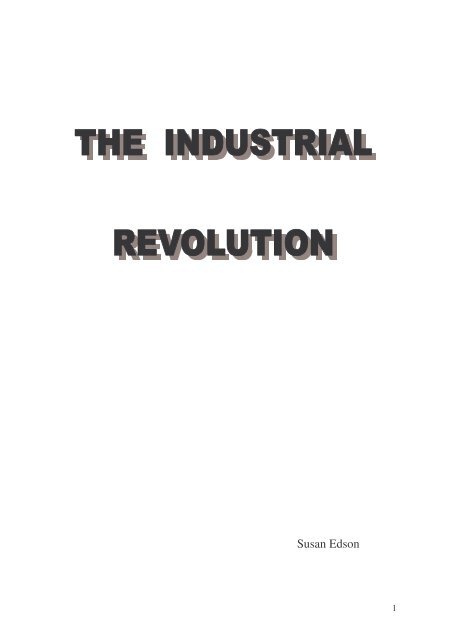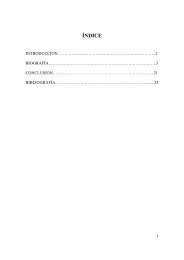The industrial Revolution - Universitat per a Majors
The industrial Revolution - Universitat per a Majors
The industrial Revolution - Universitat per a Majors
Create successful ePaper yourself
Turn your PDF publications into a flip-book with our unique Google optimized e-Paper software.
Susan Edson1
THE INDUSTRIALREVOLUTIONEscrito por:Susan EdsonDirigido por:D. Juan Carlos PalmerTrabajo presentado para la obtención delTitulo Universitario Senior<strong>Universitat</strong> Jaume ICastellón, mayo 20052
Indice:I. General Concept………………………………..……41. First <strong>industrial</strong> revolution2. Second <strong>industrial</strong> revolution3. ModernizationII. Europe………………………………………………..91. England2. Scotland3. Rest of EuropeIII. U.S.A………………………………………………...171. <strong>The</strong> growth of U.S. industry.2.Organization of <strong>industrial</strong> relations.3.Agriculture.IV. Developments and innovations………………………241. Colonialism2. Apprenticeship3. Science and technology4. Machine tools5. Textiles6. Steam engines7. Locomotives and Steamboats8. <strong>The</strong> Electric Telegraph9. Architecture10. Rubber11. Lighting12. TimeV. Conclusions………………………………………... 42VI. Bibliography………………………………………… 443
I. General Concept1. <strong>The</strong> First Industrial <strong>Revolution</strong>Between 1760 and 1830 the Industrial <strong>Revolution</strong> was mainly confined toBritain. Being aware of its head start on other countries, Britain forbade theexport of machinery, skilled workers and manufacturing techniques. Thiscould not last, as many Britons saw profitable <strong>industrial</strong> opportunitiesabroad and continental European businessmen were keen to lure Britishknow-how to their countries. Belgium became the first country incontinental Europe to be transformed economically, having machine shopsset up in Liège (c.1807) by two Englishmen, William and John Cockerill.Like Britain, the Belgian Industrial <strong>Revolution</strong> centred on iron, coal andtextiles.<strong>The</strong> <strong>industrial</strong>ization of France was slower and less thorough than that ofBritain and Belgium. At the time that Britain was establishing her<strong>industrial</strong> leadership, France was immersed in its <strong>Revolution</strong>, the uncertainpolitical situation discouraging investments in <strong>industrial</strong> innovations. By1848 France, now an <strong>industrial</strong> power, was still behind England, despitegreat growth under the Second Empire.Other European countries were far behind. <strong>The</strong>se countries lacked thewealth, power and opportunities of the French, British and Belgians. Inother nations <strong>industrial</strong> expansion was held back by political conditions.Germany, for example did not begin its <strong>industrial</strong> expansion until afternational unity in 1870, despite vast resources of coal and iron. Once begun,Germany’s <strong>industrial</strong> production grew so rapidly that by the turn of thecentury they were producing more steel than Britain and led the world inthe chemical industries. <strong>The</strong> rise of U.S. <strong>industrial</strong> power in the 19th and20th centuries left the Europeans way behind. <strong>The</strong> Japanese too joined theIndustrial <strong>Revolution</strong> with great success.<strong>The</strong> eastern European countries were even further behind in the 20thcentury. <strong>The</strong> Soviet Union became a major <strong>industrial</strong> power after the fiveyearplans, condensing into a few decades the <strong>industrial</strong>ization that hadtaken Britain a century and a half. In the mid 20th century the Industrialrevolution spread to countries such as China and India.4
2. <strong>The</strong> Second Industrial <strong>Revolution</strong>Despite overlapping with the “old”, there was evidence of a “new”Industrial <strong>Revolution</strong> in the late 19th and 20th centuries. As far as basicmaterials were concerned, modern industry had begun to exploit manynatural and synthetic resources not used before: lighter metals, new alloysand synthetic products such as plastics, as well as new energy sources.<strong>The</strong>re had also been great developments in machines, tools and computers,giving rise to automatic factories. By the mid-19th century some sectors ofindustry were almost completely mechanized, but automatic o<strong>per</strong>ation, notto be confused with the assembly line, did not become significant until thesecond half of the 20th century.<strong>The</strong> ownership of factories and businesses by small groups of people,which was characteristic of the means of production in the early mid-19thcentury gave way to ownership through the purchase of common stocks byindividuals and institutions such as insurance companies. In the 20thcentury, many European countries socialised basic sectors of theireconomies. Political theories also changed: governments moved into socialand economic areas to meet the needs of their more complex <strong>industrial</strong>societies.5
3. Modernization<strong>The</strong> Renaissance and Reformation set the west on a different path from thatof the rest of the world, with two main patterns of development:individualism, in the end, the secularism that was the Protestant legacy andthe rise of science as a method and as a practice. Both of these lead toimportant events towards the end of the 18th century. <strong>The</strong> first helped toprovoke political revolutions in America and France. <strong>The</strong> second createdan atmosphere conducive to technological innovation, which was one ofthe chief elements in the emergence of the Industrial <strong>Revolution</strong> in GreatBritain.<strong>The</strong> American and French revolutions established the political character ofmodern society as constitutional and democratic.This does not mean that from then on every government was of suchcharacter, but even those that were not claimed to be. From the time ofthose revolutions it became clear that no political system could claimlegitimacy if it wasn’t in some way based on “the will of the people,”constitutionally expressed. <strong>The</strong> French aristocrat Alexis Tocqueville wrotebrilliantly about these principles in his works, <strong>The</strong> Ancien Régime and the<strong>Revolution</strong> (1856) and Democracy in America (1835-1840).Popular or constitutional dictatorships such as those of Napoleon III inFrance and Adolf Hitler in Germany claimed to be democratic whichshows how central the double idea of democracy and constitutionaljustification had become. But they were not infinitely malleable. Lots ofold-fashioned monarchies and empires fell before the march of moderndemocratic theory. In the United Kingdom democracy was gained througha gradual extension of the franchise in the 19th century. Autocraticintransigence was overcome in Russia and in eastern and central Europe byviolent revolution, defeat in war and nationalist tendencies.By whatever means it has been accomplished – the democraticconstitutional state has come to be accepted as in principle the only fullylegitimate polity in modern society. States where democracy does notexist, for instance, in communist states or military dictatorships, feelcompelled to justify their conduct, pleading special or emergencyconditions, with a professed goal of democracy, sometime in the nearfuture.<strong>The</strong> American <strong>Revolution</strong> added another aspect to the political form ofmodern society. It asserted the principle of self-determination. <strong>The</strong> onlystates which were legitimate were those in which people of a common6
culture ruled for themselves a common territory. “National selfdetermination”became one of the most powerful catchphrases of theliberal and radical ideologies that largely shaped the modern states of the19th and 20th centuries.This self-determination was extremely difficult to achieve in eastern andcentral Europe where the question of whose nationality should be the basisof the state divided ethnic groups bitterly and it became a powerful factorin the dissolution of Europe’s overseas empires.If the American and French revolutions laid down the political pattern ofthe modern world, the Industrial <strong>Revolution</strong> in Great Britain laid down theeconomic pattern. Great Britain was the pioneer <strong>industrial</strong> nation of theworld and the changes which took place there during the 19th centurybecame almost a prototype of <strong>industrial</strong>ization. Other countries who choseto <strong>industrial</strong>ize copied Great Britain: there was simply no other model.Certain tendencies in the British case were characteristic of <strong>industrial</strong>development. <strong>The</strong>se included the movement from rural areas to cities, themassing of workers in the new<strong>industrial</strong> towns and factories andthe rise of distinctions betweenfamily life and work life, andbetween work and leisure asnotions with a meaning for largeclasses of people. Industrializationbrought about a whole new socialsystem and way of life.At the time some Englishnovelists, such as Charles Dickensand Elizabeth Gaskell wrote abouturban and <strong>industrial</strong> life in Britain.Foreigners such as AlexisTocqueville, Friedrich Engels andKarl Marx observed and reflectedthe changes they saw in Englandin a systematic analysis of the newsociety. <strong>The</strong>y were convinced that what was happening in Britain would berepeated in other societies as they underwent <strong>industrial</strong>ization. In workssuch as Engels’ <strong>The</strong> Condition of the Working Class in England in 1844(1845), and Karl Marx’s Das Kapital (1867-1894), British ex<strong>per</strong>ience was7
examined for the light it shed on the general process of <strong>industrial</strong>izationand for what it suggested of future developments, there and elsewhere.One consequence of the tendency to generalize the British ex<strong>per</strong>ience itselfgrew in scope and significance. It came to symbolize not just the economicand technical changes, but other political, social and cultural changes thatwere connected with it, whether as causes or consequences. Thus, thedemocratic movement triggered by the American and French revolutionswas seen as the necessary political transformation that was needed in allmovement towards an <strong>industrial</strong> society. Changes in urban life, in familyform, in individual and social values, and in intellectual outlook, were allseen as linked to <strong>industrial</strong>ism. Industrial society came to stand as the bestexample of modern society. Looking back, earlier developments, such asProtestant Individualism and the scientific revolution came to be seen aspreconditions of <strong>industrial</strong>ism. Industrialism, it came to be agreed, was apackage which incorporated lots of elements which all came together.8
II. Europe1. EnglandCan the term Industrial <strong>Revolution</strong> be applied to the economictransformation of the late 18th-and early 19th century Britain? In terms ofemployment, the <strong>industrial</strong> sector may not have overtaken the agriculturalsector until the 1850s and even the average unit of production employedonly ten people. Large, anonymous factories did not become common untilthe late 19th century. Historians have argued, rightly, that industry did notsuddenly start to develop in the 1780s and that even in 1700 Britain wasmore <strong>industrial</strong>ized than its European competitors. But the availableevidence shows that by 1800 Britain was by far the most <strong>industrial</strong>izedstate in the world and that, because of this, the rate of economic growthmust have accelerated in the last third of the 18th century.Britain was able to sustain unprecedented growth in its population from1780 onward, without suffering from major famines or acuteunemployment. In 1770 the population was about 8.3 million. By 1790 ithad reached 9.7 million; by 1811, 12.1 million; and by 1821, 14.2 million.By the latter date, it is estimated that 60 <strong>per</strong>cent of Britain’s populationwas 25 year of age or under. By comparison, in Ireland, with a similardemographic growth, there was no Irish Industrial <strong>Revolution</strong>. Partly as aresult of this, Ireland suffered the great famine of the 1840s, whereas therewas no similar famine in Britain.Early <strong>industrial</strong>ization,undeniably, had its dark side.Working conditions wereoften brutal, particularly forthe young. Industrial safetywas minimal and unguardedmachines led to horrificinjuries. Mechanizationruined the livelihoods of someskilled craftsmen, mostnotably the handloomweavers. However, withoutIndustrialization the socialcosts of rapid populationgrowth in Britain would probably have been far greater.9
Although it is difficult to account for Britain’s early <strong>industrial</strong>ization, somefacts stand out. Britain, unlike its most important rival, France, was asmall, compact island. It had no major forests or mountains to impede itsinternal communications, except in northern Scotland. Britain had lots ofnatural ports facing the Atlantic, plenty of coastal shipping, and a goodsystem of internal waterways. By the 1760s there were already 1,000 milesof canals in Britain; 3,000 more miles were constructed over the next 70years. Britain also had large reserves of coal and iron ore, and theseminerals were often located close together in counties such asStaffordshire, Northumberland, Lancashire and Yorkshire.Canal transportIt was very important that Britain had an ample supply of customers for itsgoods, both at home and overseas. Its colonies provided it with rawmaterials while also serving as captive customers. And the expandingpopulation meant that there was great demand at home even in wartime,when foreign trade was disrupted. <strong>The</strong> best illustration of these advantagesis the cotton industry. Britain’s Indian settlements supplied her with everincreasingamounts of raw cotton, and annual cloth production increasedfrom 50,000 pieces of cloth in 1770 to 400,000 pieces in 1880. A lot of thiscloth was consumed by the home market. It has been argued that theincreased wearing of cotton (which could be easily washed) unlike woollenclothes (which could not) improved health conditions, thus contributing toBritain’s population expansion.10
2. Scotland<strong>The</strong> Scottish Industrial <strong>Revolution</strong> was in full swing from the 1820s. Atthis time there was a dramatic increase in population. In 1700 there were<strong>per</strong>haps one million people in Scotland, by 1800 there were more than 1.5million and by 1900 nearly 4.5 million. <strong>The</strong> greatest increases were in themanufacturing towns. Hundreds of thousands of Irish emigrants went toScotland in 19th century, notably during the Irish potato famine of 1846-1850. <strong>The</strong>re was a decrease in population in some country areas as peoplemoved to the towns, to England or overseas. Part of the increase inpopulation was due to improved medical care which had lessenedepidemic diseases in the mid-19th century. <strong>The</strong> food for this increasedpopulation was supplied by progressive Scottish agriculture. Farming inthe southeast was celebrated for its efficiency in the early 19th century, andthe northeast became famous for its beef cattle and Ayrshire for its milkingherds.But the key advance was in heavy industry, which, from about 1830, tooka lead over textiles, at a time when industry had replaced agriculture as thenation’s chief concern. <strong>The</strong> production of coal and iron rose, with JamesBeaumont Nelson’s hot-blast process (1828) making Scottish ores chea<strong>per</strong>to work. Major canals, such as the Forth and Clyde, completed in 1790were very important for transport before being made redundant by therailways, of which the Glasgow-to-Garnkirk (1831) was noteworthy forusing steam locomotives (instead ofhorses) from the start. Above allScotland was made famous for thebuilding of ships, mainly onClydeside. Robert Napier was thegreatest of many great Scots marineengineers.Horse-drawn trainSteam engine11
3. Rest of Europe<strong>The</strong> development of modern Europe between the1780s and 1849 wasstrengthened by an unprecedented transformation that included the firststages of the great Industrial <strong>Revolution</strong> and even more general expansionof commercial activity. Europeans were initially more impressed by thepolitical news generated by the French <strong>Revolution</strong> and ensuing NapoleonicWars, but really the economic upheaval, which related to political anddiplomatic trends, has proved to be more fundamental.Major economic growth was encouraged by western Europe’s tremendouspopulation growth during the late 18th century, extending well into the19th century. Between 1750 and 1800, the populations of major countriesincreased by 50 to 100 <strong>per</strong>cent, mainly as a result of new food crops (suchas the potato) and a decline in epidemic disease. <strong>The</strong> increase in survivingchildren in peasant and artisan families made it necessary for them to seeknew forms of paying labour.Growth in commercialisation showed in a number of areas. Energeticpeasants increased their landholdings, often at the expense of theirneighbours, which increased the number of poor, near-pro<strong>per</strong>ty-lesspeople. <strong>The</strong> peasants produced food for sale in the growing urban markets.Domestic manufacturing soared, as hundreds of thousands of ruralproducers worked full or part-time to make thread, cloth, nails and toolsunder the sponsorship of urban merchants and craft workers in the citiesstarted to produce goods for overseas. Europe’s social structure changedtowards a basic division, both rural and urban, between owners and nonowners.Production expanded, leading by the end of the 18th century to afirst wave of consumerism as rural wage earners began to buy new kinds ofcommercially produced clothing. At the same time urban middle-classfamilies bought such things as books and educational toys for theirchildren.In this way an outright <strong>industrial</strong> revolution took shape, led by Britain,which remained the leader in <strong>industrial</strong>ization until well past the middle ofthe 19th century. In 1840 British steam engines were generating 620,000horsepower out of a European total of 860,000. Even so, though delayedby the French <strong>Revolution</strong> and Napoleonic Wars, many western Europeannations soon caught up, so that by 1860 British steam-generatedhorsepower made up less than half the European total, with France,Germany and Belgium gaining ground rapidly. By 1820, with governmentsand private concerns imitating British technologies, there was an intense<strong>industrial</strong> revolution taking shape in many parts of western Europe,12
particularly in coal-rich regions such as Belgium, northern France and theRuhr area of Germany. In 1825 Germany produced just 40,000 tons of pigiron, increasing to 150,000 tons a decade later and reaching 250,000 tonsby the early 1850s. French coal and iron output doubled in the sameamount of time.Technological changes soon affected other areas. <strong>The</strong> increase inproduction made more demands on the transportation system to move rawmaterials and finished products. <strong>The</strong> answer was massive road and canalbuilding and also the use of steam engines. Soon after 1800 steam shipswere used on major waterways and by the 1840s in oceanic transport.Railroad systems, which were first developed to haul coal from mines,were developed for intercity transport during the 1820s; the firstcommercial line was opened between Liverpool and Manchester in 1830.During the 1830s local rail networks grew in most western Europeancountries, with national systems being completed by about 1870. <strong>The</strong>invention of the telegraph speeded up communications, allowing fasterexchange of news and commercial information than ever before.New organization of business and labour was linked to the newtechnologies. Workers in the <strong>industrial</strong>ized sectors worked in factoriesinstead of in scattered shops or homes. Steam and water power requiredfactories and the labour force to be near the power source. Concentrationof labour also allowed new discipline and specialization, which increasedproductivity.<strong>The</strong> new machinery was expensive and substantial capital had to beaccumulated, through partnerships, loans from banks, or joint ventures, toset up even modest factories. Although small firms still predominated, atendency towards expansion of the business unit was already noticeable.Commerce was affected in similar ways; new forms were developed todispose of growing levels of production. Small shops replaced peddlers invillages and small towns. In Paris, the department store, introduced in the1930s, lead to an age of big business in the trading sector.Urbanization was a vital result of growing commercialisation and new<strong>industrial</strong> technology. Factory centres such as Manchester grew fromvillages into cities in a few decades. <strong>The</strong> <strong>per</strong>centage of the populationlocated in cities increased steadily , and big cities displaced the morescattered centres in urban western Europe. <strong>The</strong> rapid growth of new citiesproduced new hardships, as housing and sanitary facilities could not keeppace, although improvements were made. Gas lighting of the streets in thebetter neighbourhoods from the 1830s onward, improved street conditions13
and sanitary reformers pressed for underground sewage systems at aboutthis time. <strong>The</strong> better-off lived in suburban areas, thus escaping the miseriesof urban life.Rural life changed less dramatically. Technological revolution did notoccur in the countryside until after the 1850s. However, factory-made toolswere widely used before this time, creating a substantial improvement inproductivity. Larger estates introduced new equipment, such as seed drillsfor planting. Crop rotation was introduced, involving the use of nitrogenfixingplants (for example turnips), instead of the age-old practice ofleaving some land fallow. Better seeds and livestock and, from the 1830s,chemical fertilizers improved yields too. <strong>The</strong> increase in agriculturalproduction was very important to the growth of cities and factories.By 1850, in Britain, still the leader in the Industrial <strong>Revolution</strong>, only halfthe total population lived in cities, with Europe way behind. <strong>The</strong>re werestill as many urban craft producers as there were factory hands. In otherwords, traditional economic centres did not disappear and even expandedbecause of more need for housing construction and food production.Geographic differences complicated matters too. From the 1840s, greatprogress was made by many of the German states and Belgium, whichbrought them steadily closer to British levels. France, which was poorer incoal, concentrated more on increasing production in craft sectors,converting furniture making, for example, from an artistic endeavour tostandardized output, and, eventually factory produced goods. Scandinaviaand <strong>The</strong> Netherlands did not join <strong>industrial</strong>ization until after 1850.Russian Peasants14
Southern and eastern Europe, while importing a few model factories andlaying some local railway lines, had different economic tendencies. Citygrowth and technological change were both modest until much later in the19th century, except for pockets of northern Italy and northern Spain.Western Europe’s <strong>industrial</strong>ization made its greatest impact in easternareas by encouraging a growing conversion to market agriculture, asRussia, Poland and Hungary responded to the need for grain, particularlyin the British Isles. As in eastern Prussia, an increase in the workrequirements was put on peasant serfs working on large estates, to meetexport possibilities without fundamental technical changes and withoutchallenging the power of the landlords.15
4. AgricultureEurope was the first of the major world regions to develop a moderneconomy based on commercial agriculture and <strong>industrial</strong> development. Itssuccessful modernization is due to rich economic resources, its history ofinnovations, the evolution of a skilled and educated workforce and the easeof interconnections – both natural and man-made – which made it easy tomove massive quantities of raw materials and finished goods.Europe’s economic modernization began with a marked improvement inagricultural output in the 17th century, particularly in England. <strong>The</strong>traditional method of leaving land fallow was replaced by continuouscropping on fields fertilized with the manure of animals which were raisedfor food for the rapidly expanding urban markets. <strong>The</strong> wealth accumulatedby the landowners and abundant cheap labour fuelled the development ofthe Industrial <strong>Revolution</strong> in the 18th century.During the 18th century towns and cities ever increasing, needed more andmore food. At the same time the British aristocratic taste for improvingtheir estates and decorative country houses transformed the traditionalagricultural system. This was a essentially a British development, anindication of the pressures of <strong>industrial</strong>ization even before the Industrial<strong>Revolution</strong>. Other European countries, with the exception of theNetherlands, from which several agricultural innovations were acquired bythe British, did little to encourage agricultural productivity. <strong>The</strong>transformation was complex and not completed until well into the 19 thcentury. It consisted partly of a legal reallocation of land ownership, the“enclosure” movement, to make farms more compact and economical too<strong>per</strong>ate. Land owners were encouraged to invest money in their estatesinstead of just drawing rents from them. This money was used for technicalimprovements, in the form of machinery – such as Jethro Tull’smechanical sower – better drainage, scientific methods of breeding to raisethe quality of livestock and ex<strong>per</strong>imenting with the new crops and systemsof crop rotation. This process has been described as an agriculturalrevolution, but it was really a prelude to and part of the Industrial<strong>Revolution</strong>.16
III. U.S.A.1. <strong>The</strong> growth of U.S. industryBy 1878 the U.S. had entered a <strong>per</strong>iod of pros<strong>per</strong>ity after a longdepression. In the following 20 years the number of workers,manufacturing plants and the volume of <strong>industrial</strong> production all more thandoubled. <strong>The</strong> aggregate annual value of all manufactured goods increasedfrom about $5,400,000,000 in 1879 to some $13,000,000,000 in 1899.<strong>The</strong>expansion of the iron and steel industry, of great importance in any<strong>industrial</strong> economy, was even more impressive; from 1880-1900 theproduction of steel in the U.S. went from 1,400,000 tons to 11,000,000tons. Before the end of the century the U.S. overtook Great Britain in theproduction of iron and steel and provided more than one quarter of theworld’s supply of pig iron.Many factors combined to produce this great <strong>industrial</strong> activity. <strong>The</strong>resources of Western states were exploited, including mines and timber,stimulating a demand for improved transportation, and the gold and silvermines provided capital for investment in the East. <strong>The</strong> new railroads,mainly in the West and South, caused a demand for more steel rails andwas a major force in the expansion of the steel industry. Railroad mileagein the U.S. increased from 93,262 miles (150,151 kilometres) in 1880 toabout 190,000 miles (310,000 kilometres) in 1900. New techniques in theproduction of steel, such as the Bessemer and open-hearth processesresulted in improved products and lower production costs. Many majorinventions, including the telephone, typewriters, electric light, automobile,etc., became the basis of new industries with many of them revolutionizingthe conduct of business. <strong>The</strong> use of petroleum products in industry, as wellas for domestic heating and lighting, became the cornerstone of the mostpowerful of the new industries of the <strong>per</strong>iod. <strong>The</strong> corporate form ofbusiness was widely used, offering new opportunities for large-scalefinancing of business enterprise, which attracted new capital, much of itfrom overseas investors. <strong>The</strong> best known businessmen of this era wereJ. D. Rockefeller, in oil, Andrew Carnegie, in steel, and such road buildersand promoters as Cornelius Vanderbilt, Leland Stanford and James J. Hill.17
2. Organization of <strong>industrial</strong> relationsClassical economists treated workers as an instrument of production,subject to the same economic laws of supply and demand as raw materialsand finished goods. In the 1890s, Frederick W. Taylor and an American<strong>industrial</strong> engineer devised a system of “scientific management”. Taylorused time and motion studies to analyse jobs by timing each task andmovement. From these studies Taylor derived the most efficient way toorganise his factories, but he did not consider how workers could beencouraged to work together more efficiently.Ford T (1917)With the successof Henry Ford’sModel T, ofwhich more than15,000,000 werebuilt between thefirst in 1908 andthe last in 1927,the company hadto solve theproblem of howto produce thecar in largenumbers and at alow cost.In 1913 Ford displayed to the world the first complete mass productionassembly-line for motor vehicles.<strong>The</strong> technique consisted of two basic elements: a conveyor system and thelimitation of each worker to a single repetitive task. Although it was simplethe technique needed elaborate planning and synchronization.<strong>The</strong> first assembly line <strong>per</strong>mitted very minor variations to the basic model,a limitation compensated by the low cost.In the late 1920s, Elton Mayo studied productivity at the WesternElectrical Company. Mayo hoped to discover optimum lighting levels andtimings of rest <strong>per</strong>iods, but he found that any group he tested improved itsproductivity merely because it had been chosen for an ex<strong>per</strong>iment.18
Although the conclusion was challenged, it marked the beginning of thesystematic study of <strong>industrial</strong> relations, noting that workers respond topsycho-social, as well as economic stimuli.As the Industrial <strong>Revolution</strong> brought large groups of workers together,frequently in unpleasant circumstances, managers and foremen becameincreasingly necessary to discipline and coordinate the workers and avariety of management strategies evolved.A foundry<strong>The</strong>re are two major schools of management styles, laissez-faire andpaternal. With the former the management feels no obligation to itsemployees outside the workplace, aiming only at profit. <strong>The</strong> paternal styleof management, however, assumes that they have obligations to theirworkers outside the workplace and to the community.Workers are motivated by factors other than wages. Incentive systems,which adjust pay according to production, make workers <strong>per</strong>form muchbetter.19
May Day Parade (Organised by unions)<strong>The</strong> relations between managers of different divisions of a firm and therelations of managers with their su<strong>per</strong>iors are as complex as those betweenmanagers and workers. Relations between managers and trade (labour)unions involve both conflict and coo<strong>per</strong>ation with the unions demandingbetter pay scales and working conditions for their members.Each individual firm’s style of management is determined by the nature ofthe industry as a whole; profitability, competitive situation, the<strong>per</strong>sonalities of its senior managers and the characteristics of the firm’shome country or region.20
3. AgricultureSince the founding of Virginia in 1607 agriculture was the most importantactivity in the U.S. until about 1890. In the 20th century U.S. agriculturedeclined rapidly in relative economic importance, but still continued to bethe most efficient and productive in the world, its success resting onabundant fertile soil, moderate climate, growing markets at home andabroad and the application of science and technology to farming.<strong>The</strong> first settlers had to grow crops which were new to them as Europeanagriculture could not be easily adapted to the new environment. Each areagrew different crops according to climate, producing enough for itself andsome left over for sale. Virginia grew tobacco as a main crop; SouthCarolina, rice; Maryland, corn; etc. <strong>The</strong> plantation system was developedto produce tobacco, rice and cotton, with black slaves providing most ofthe labour.Cotton pickingCotton was grown for home use only until it became an importantcommercial crop, thanks to the cotton gin, which was invented by EliWhitney in 1793. This machine made it easier to extract the seeds from thecotton.Between the American <strong>Revolution</strong> and theCivil War tens of thousands of farmers movedwestwards to the Ohio and Mississippi valleys.A grain-livestock empire was formed there. Inthe south farmers pushed into Alabama andMississippi and as far west as Texas,establishing vast cotton plantations. By 1860there were 2,044,077 farms. Agriculture expanded because of choicefarmlands, canal and railroad development, more demand for food from21
growing towns and cities, increasing exports and improved farmmachinery.<strong>The</strong> greatest improvements were made by the change from human toanimal power and the use of labour-saving machines. Besides the cottongin there were iron and steelploughs, rea<strong>per</strong>s, threshingmachines, grain drills, corn andcotton planters and iron harrowsand cultivators. <strong>The</strong>se machineswere drawn by oxen and horses.<strong>The</strong> amount of man-hours it tookto grow and harvest wheat in1800 had halved by 1840. An early ploughFarmers were advised by agricultural reformers to rotate their crops, butmost just ploughed up new lands when the fertility of their land declined.By the 1860s farmers supplied many of their own needs, but increasinglysold their produce, much of it abroad, and bought manufactured goods.Following the Civil War agriculture expanded at an even faster rate, withfarmers migrating to the Great Plains, Rocky Mountains and West CoastStates. With the endof slavery the numberof farms rose from 2million to 6.4 millionbetween 1860 and1916 as free blackpeople started theirown farms. Farmmachines continuedto improve andmachines such as thesteam tractor wereintroduced.Steam tractorAlthough agriculture was highly productive, the farmers were notpros<strong>per</strong>ous. In 1900 the average income <strong>per</strong> worker was only $260annually compared to $622 for non-agricultural workers . Between 1900and World War I, however, farmers ex<strong>per</strong>ienced better times as farmproduce was in high demand and land values rose.22
<strong>The</strong>n in 1920 the post war deflation hit farmers badly, with agriculturalprices dropping way below non-agricultural prices. Congress helped bypassing new laws and subsidizing exports.Shortly after World War II the horse age in farming came to an end. Biggerand better machines reduced the amount of labour needed in agriculture.Another aspect of the revolution was the use of chemicals in fertilizers,insecticides and herbicides. New hybrid seeds were developed and therewere dramatic changes in feeding and artificial breeding of animals andthere was much better control of crop and livestock diseases.By the end of the 20th century organic farming was introduced in responseto health and environmental concern. Farms increased sharply in size, butless labour was needed. In 1940 there were 6.1 million farms, averaging215 acres in size. By 1980 there were only 2.4 million farms, but theaverage size was 431 acres. In 1930 some 30 million Americans lived onfarms - 25 <strong>per</strong>cent of the population, but nowadays much of the nation’sfarm production and distribution is in the hands of large agribusiness firms.23
IV. Developments and innovations1. ColonialismParallel with increasing rivalry among existing colonial powers was therise in <strong>industrial</strong>ized nations challenging Britain’s supremacy in industry,finance and world trade. Although Britain’s economy in the mid-19thcentury was far ahead of its potential rivals, by the last quarter of thatcentury Britain was confronted by competitors wanting a greater share ofworld trade and finance. <strong>The</strong>se nations had become more <strong>industrial</strong>izedand were spurred on by the spread of the railways and the maturation ofintegrated national markets.Moreover, the major technological advances of the late 19th and 20thcenturies helped the newer <strong>industrial</strong> nations to compete. Great Britain’sadvantage in being the forerunner of the Industrial <strong>Revolution</strong> diminishedconsiderably as newer products and sources of energy began to dominate<strong>industrial</strong> activity. <strong>The</strong> late starters were now on a more equal footing withGreat Britain; having digested the first Industrial <strong>Revolution</strong> all nationswere starting out, more or less, from the same base to exploit the secondIndustrial <strong>Revolution</strong>. This new <strong>industrial</strong>ism, notably featuring <strong>industrial</strong>chemistry, the internal combustion engine, mass-produced steel, electricpower, and oil as sources of energy, spread over western Europe, theUnited States, and eventually Japan.24
2. ApprenticeshipsAttitudes towards training changed during the Industrial <strong>Revolution</strong>.Unskilled labour was needed to work machines and the workers whoshowed aptitude moved on to semi-skilled jobs. Craftsmen were stillneeded, both to build machines and keep them running, so apprenticeshipcontinued in these trades dependant on individual skills. Skilled workerswere recruited into trade unions who worked to maintain standards andprotect the workers. As the factory replaced domestic industry, apprenticeswere trained by the factories where they would later have jobs as skilledworkers.In France there was an early reaction against free admission to all tradesand legislation concerning apprenticeships was reintroduced in 1803 andstrengthened in 1851. In the reconstruction of Prussia, which began duringthe Napoleonic Wars, apprenticeship became an important feature of<strong>industrial</strong> training. In England apprenticeship was maintained by the craftindustries and even extended to similar fields. Pupil teachers were used ineducation, which was, in effect, a kind of apprenticeship, young farmerswere trained in the same way.In the United States apprenticeship existed during colonial times.Indentured apprentices were taken from England in the 17th century, butapprenticeship was less important because of the high proportion of skilledworkers among immigrants.<strong>The</strong> development of large scale machine production increased the need forsemi-skilled workers, whose skills were confined to a particular speciality.Labour became more divided with the more ambitious looking foradvancement through study. Mechanics’ institutes were established to meetthis need.A 19th century officeA modern office25
Preparation for clerical work was more clearly associated with the regulareducation system. In the late 19th century evening schools wereestablished to prepare students for employment as clerks, cashiers andbook-kee<strong>per</strong>s. Later secretarial schools were made necessary by theinvention of the typewriter and the use of shorthand. Nowadays trainingfor office work is done after recruitment.For the new technology, theoretical understanding and skills were neededfor which universities made no provision. <strong>The</strong> French École Polytechniquewas established in 1794 and was the earliest attempt to meet theserequirements. <strong>The</strong> École Polytechnique soon became a great scientific andtechnological institution and was the first of the great professional schools(grandes écoles), peculiar to France.<strong>The</strong> École Polytechnique still exists with each profession having its ownschool; for example, the School of Mines, the School of Roads andbridges, the National School of Agriculture and, more recent creations, theSchool of Aeronautics and the National School of Administration. Specialpreparation is needed to be admitted to any of these schools.École Polytecnique26
3. Science and technology<strong>The</strong> history of technology is much longer and different from that ofscience. Technology is the systematic study of techniques for making anddoing things; science is the systematic attempt to understand and interpretthe world. While technology is concerned with the making and use ofartefacts, science is devoted to understanding the environment; andcomparatively sophisticated skills of literacy and numeracy are needed todo this. Science only really began with the great world civilizations, some3,000 years B.C., but technology is as old as mankind.Primitive toolsScience and technology developed as different and separate activities,science being practiced by a class of aristocratic philosophers, whiletechnology was a matter of practical concern to craftsmen of many types.Sometimes science and technology crossed paths, such as the mathematicalconcepts in building and irrigation work, but for most of the time thefunction of scientists and technologists remained apart in ancient cultures.In medieval times things changed; both science and technology werestimulated by commercial expansion and urban culture. <strong>The</strong> fast growth intechnology attracted the interest of educated men; in the early 17th centurythe natural philosopher Francis Bacon recognized the magnetic compass,the printing press and gunpowder as great achievements of modern man.Bacon urged scientists to study the methods of craftsmen, and craftsmen tolearn more about science, thus harmonizing science and technology.Bacon, Descartes and their contemporaries advocated ex<strong>per</strong>imental scienceas a way of enlarging man’s dominion over nature.27
<strong>The</strong> union of science and technology proposed by Bacon did not happenovernight. Over the next 200 years or so carpenters and mechanics builtbridges, steam engines and textile machines with little reference toscientific principles while scientists – still amateurs – pursued theirinvestigations in a haphazard way. A body of men, inspired by Bacon,formed <strong>The</strong> Royal Society in London in 1660, representing a determinedeffort to direct scientific research towards useful ends, first by improvingnavigation and cartography and ultimately by stimulating <strong>industrial</strong>innovation and the search for mineral resources. Similar bodies of scholarsdeveloped in other countries, and by the 19th century scientists weremoving towards a professionalism in which the goals were much the sameas those of the technologists. Justus von Liebig of Germany, a leader inorganic chemistry, was one of the first scientists to propose the use ofmineral fertilizer and provided the scientific impulse in the development ofsynthetic dyes, high explosives, artificial fibres and plastics, and MichaelFaraday, the brilliant British scientist in the field of electromagnetismprepared the ground for the inventions of Thomas A. Edison and others.<strong>The</strong> invention of the light bulb by Edison in 1879 resulted in the creation atMenlo Park N.J. of what is considered the world’s first genuine <strong>industrial</strong>research laboratory, deepening the relationship between science andtechnology. After this achievement the application of scientific principlesto technology grew rapidly. It led to better organization of workers inmass-production, applied by Frank W. Taylor and to the time and motionstudies of Frank and Lillian Gilbreth at the beginning of the 20th century.Henry Ford applied this model to his automobile assembly plant and theexample was followed by every modern mass-production process. As aresult systems engineering,o<strong>per</strong>ations research, stimulationstudies, mathematical modellingand technological assessmentdeveloped in the <strong>industrial</strong>processes. Technology influencedscience too, creating new tools andmachines with which the scientistscould achieve more insight into thenatural world. Together thesedevelopments brought technologyto its modern efficient level of<strong>per</strong>formance.Thomas A. Edison28
4. Machine tools<strong>The</strong> making of machines to make machines was one of the most importantaspects of the Industrial <strong>Revolution</strong>. Machine tools can be traced back forcenturies, but it wasn’t until the late 17th century that clock makers,builders of scientific instruments and furniture and gun makers began tochange from wood-working lathes to ones capable of machining tool steel.<strong>The</strong>y needed a variety of gear- cutting, grinding and precise screw cuttingmachines to make their products. <strong>The</strong> development of precise machinetools affected the art of navigation and paved the way for the <strong>industrial</strong>machine tools of the late 18th and early 19th centuries, which made itpossible to construct the steam engine and the machines it had to power.This in turn improved the standards of living for people throughoutwestern Europe and North America.<strong>The</strong> first screw-cutting lathes were made by an English instrument maker,Jesse Ramsden (1735–1800) in 1770. Henry Maudslay (1789-1864)produced a screw cutting lathe in 1800, which was accurate to 1/10,000 ofan inch. Three of Maudslay’s assistants developed varieties of machinetools. Richard Roberts (1789-1864) introduced a more powerful lathe, andin 1817 built the first planning machine for metal and soon after his firstgear-cuuting machine. He also improved the spinning mule and designed apunching machine for making rivet holes in 1847. Joseph Whitworth(1803-1887) improved and enlarged many of Maudslay’s early machinetools. He is best known for constructing a measuring machine with anaccuracy of one millionth of an inch , and for first suggesting thestandardization of screw threads. James Naysmyth (1808-1890), another ofMaudslay’s protégés, invented the milling machine and a planing machineor sha<strong>per</strong>.However, John Wilkinson, the ironmaster, (1728-1808), was probably thegreatest machine toolmaker in England. He invented the cylinder boringmachine (the boring mill) circa 1775 that made Watt’s steam engine apractical source of power. He was the first to demonstrate that coke couldbe used instead of coal to produce quality iron on a large scale. In 1779 hedesigned the first all-iron bridge constructed in England and his factorycast the iron for it. In 1787 he built the first iron barge to transport hisgoods down the River Severn. He was an <strong>industrial</strong> genius whose name isattached today to Wilkinson razor blades.29
5. TextilesAlthough the textile industry remained a cottage industry until the 18 thcentury, workers occasionally o<strong>per</strong>ated together under one roof, there wasone such mill as early as 1568 in Zurich and another in Derby, England in1717. Factory organization advanced mainly in the north of England andthe Industrial <strong>Revolution</strong>, at its height between 1760 and 1815, greatlyaccelerated the growth of the mill system.Many new machines for the textile industrycaused riots, and laws prohibited their introductionbecause they put so many people out of work. <strong>The</strong>first modern invention that increased the loom’sefficiency was John Kay’s flying shuttle, patentedin 1733. This device resulted in greaterproduction from a single loom, cloth of agreater width and a reduction in the number ofworkers on the looms. Kay’s invention wasvery unpopular with weavers because of theirfear of becoming unemployed. In 1755 Kaywas attacked by a mob and one of his looms wasdestroyed. Kay died a destitute man in 1764although his machine was widely used after his death.Hand loom<strong>The</strong> next major improvements were brought about by Richard Arkwright’s(1732-1792) spinning machine and James Hargreaves’ (d.1778) inventionof the spinning jenny. Arkwright’s machine needed mechanical power andbegan the move from spinning as a cottage industry to a factory system. Itproduced the first practical cotton warp, which made it possible to produceall-cotton goods. Hargreaves’ machine made it possible to use finer andstronger yarns than ever before.<strong>The</strong> history of inventions in the textile industry shows how the invention ofmachines which radically improved output in one branch of the tradecreated a need for fresh inventions in other branches to catch up with thedemand for their products. By the time Edward Cartwright had <strong>per</strong>fectedhis power loom the whole English cotton manufacturing industry neededbigger supplies of raw cotton. <strong>The</strong> demand was met with the invention ofEli Whitney’s cotton gin, which made it quicker and easier to clean cotton,thus increasing supplies.30
<strong>The</strong> invention of the sewing machinein the mid 19th century increased thedemand for textiles. <strong>The</strong> sewingmachine was unique in that it was thefirst major consumer appliance. <strong>The</strong>first machine was invented by EliasHowe (1819-1867) in 1843. It wasbased on lockstitch and could onlysew straight seams. Isaac Singer(1811-1876) invented the first reallypractical, domestic sewing machine in1851. His machine had a straightneedle, foot treadle and could sewcurved seams. Singer sewingmachines were sold on an instalmentbasis, making them an affordable item. Singer is still one of the biggestproducers of sewing machines and is well known.A modern sewing machine31
6. <strong>The</strong> Newcomen and Watt Steam EnginesThomas Newcomen (1663-1729) was an English blacksmith who inventedan atmospheric engine. Steam was admitted to a cylinder, condensed by ajet of cold water, and the vacuum created in the cylinder o<strong>per</strong>ated a piston,which was forced downwards on its working stroke. Together withThomas Savery who had invented a similar pump in 1698, Newcomen andhis other partner, John Calley, built their first engine on the site of a waterfilledmine in 1712. <strong>The</strong>se engines were very slow and inefficient, but theywere better than anything yet invented to pump water out of mines.James Watt (1736-1819) improved the Newcomen engine by fitting it witha separate condenser, which could be connected to thecylinder by a valve. <strong>The</strong> condenser could be kept coolwhile the cylinder was kept hot (something notachieved by Newcomen). To a large extent Watt’sengines were responsible for many of theimprovements brought about by the Industrial<strong>Revolution</strong>.James Watt32
7. <strong>The</strong> Steam Locomotive and the SteamboatWatt’s patent for a separate condenser covered the use of high pressuresteam, but he refused to develop an engine using this as he was worriedabout boiler explosions and bursting pipes. However, when Watt’s patentran out in 1800 other inventors used high pressure steam. RichardTrevithick (1771-1833) built several full sized steam carriages, which ranon English roads, using a cylindrical boiler and high pressure steam.During the first decade of the 19th century he built several more steamcarriages, called locomotives, which were used for hauling coal and ore outof mines.Railways had existed in Britain for about two centuries, first using horsesto haul wagons on wooden tracks and later on iron-edged rails. By 1825people like Trevithick and George Stephenson had invented a boxlikeaffair on wheels, propelled by a fire burning engine, which ran on rails andcarried cargo many times its own weight. <strong>The</strong> first public railway wasopened in 1825 on theStockton and Darlingtonline and was worked by aStephenson locomotive.During the 19th centuryBritish steam locomotiveswere exported to manycountries.<strong>The</strong> first practical steamboat was built by William Symington ((1763-1831) in Scotland in 1801. Robert Fulton (1765-1815), an American,constructed the “Clermont”, whichhad side paddles and was poweredby a Boulton and Watt engine. Itbegan o<strong>per</strong>ations, carrying farepaying passengers on the HudsonRiver in 1807. Within decadessteam-powered boats were makingtransatlantic crossings, greatlyincreasing commercialpossibilities.33
8. <strong>The</strong> Electric Telegraph<strong>The</strong> invention of the telegraph is usually credited to Samuel F. B. Morse(1791-1872). Although he did invent the Morse code, the real credit shouldbe given to two Englishmen, William Cooke(1806-1879) and CharlesWheatstone (1802-1875). Cooke became intrigued by the telegraph afterseeing a demonstration of an early system by a Russian diplomat. <strong>The</strong> twomen devised an instrument that contained six wires and five o<strong>per</strong>atingneedles, instead of a wire for each letter of the alphabet, which wascommon at the time. In1839 they installed atelegraph line along theGreat Western Railwayand it was used initiallyto report the position oftrains. Cooke andWheatstone’s telegraphwas the first to be offeredto the public as acommercial service andthe first use of electricityin a commercialenterprise in the world. Combination key / sounder 1875At the same time, Morse was in theU.S.A., asking Congress for funds todevelop his own system. After makinga congressman his partner he receivedthe money and a telegraph line wasbuilt between Baltimore andWashington D.C. <strong>The</strong> first messagewas sent in 1844, using Morse’s code.After a time his single wire and singleneedle system proved effective andbecame widely used.Telegraph post and wires34
9. ArchitectureHenry Bessemer (1813-1898) discovered a process of making steel cheaplywhich led to its use in the construction industry. George Fuller (1851-1900), a young man who worked drawing building plans became interestedin the problem of load bearing capacities and how much weight each partof a building would carry. During the 1880s he moved to Chicago and setup business as a building contractor, where his firm built the TacomaBuilding, which was the first structure ever built where the outer wallscarried no burden and served no purposeother than to keep out the elements andprovide a facade. In 1902 Fuller and anarchitect, David Burnham, designed andbuilt the 21 storey, triangular FlatironBuilding on the corner of Broadway and23 rd – it was New York’s firstskyscra<strong>per</strong>. Once George Fuller’sconstruction firm had paved the way,others followed and today about half ofall the large apartment and officebuildings in the U.S. are built on his steelcage system.<strong>The</strong> iron bridge at Coalbrookdale,England (built 1777-1779), which stillstands today, is another fine exampleof what could be achieved with thedevelopment of new materials andprocesses.Coalbrookdale BridgeCrystal Palace, a huge iron and glassstructure, which was designed by SirJoseph Paxton, in only ten days, forthe Great Exhibition in London, in1851 was conceived to symbolizethe <strong>industrial</strong>, military andeconomic supremacy of GreatBritain.Crystal Palace35
10. RubberToday we take modern materials for granted and do notrealize that many are relatively recentdiscoveries or inventions. Rubber, forexample, is a vital component of carsand also supplies us with manydomestic items (hot waterballoons, etc.), officeerasers, etc.) and articles for(footballs, golf balls, tennisbottles, mattresses, toyproducts (rubber bands,leisure and entertainmentballs, etc.).Rubber was discovered by theSpanish invaders of SouthAmerica in the 15th – 16thcenturies, but despite this it wasnot until about 1730 that rubberwas introduced into Britain andnot until 1791 that its use for themackintosh (rubber raincoat) wasintroduced. Rubber was not widelyused as, with time, it deterioratedin air, becoming very sticky andunmanageable. This changeddramatically with the invention of“vulcanization”, in 1834.Taking latex from a rubber treeGoodyear found that cooking the material with raw sulphur stabilized itand also stiffened the products made with the substance. It came to be usedfor an increasing number of products, such as tyres, Wellington boots andimproved mackintoshes, and rubber and textile were combined to producewaterproof fabric. It took over 40 years to develop the heavy duty car tyreswe have today.As yet Brazil was the only supplier and growing demand made the pricesoar, creating rich entrepreneurs who exploited the natives that collectedthe raw latex from the rain forest. This commodity monopoly was brokenby taking young trees raised, from seeds collected in Brazil by Sir HenryWickham, in 1876, in greenhouses in London’s Kew Gardens andtransplanting them in Ceylon (Sri Lanka) and Malaysia in large36
plantations. <strong>The</strong>se countries were able to meet the rising demand of therubber industry, and the price of raw rubber fell dramatically.With the Second World War much of world’s natural rubber productionwas lost to the Japanese, resulting in the invention of synthetic rubber, ofwhich there are many types, made from gas or oil.Lots different types of synthetic rubber are available to designers today,many for special tasks requiring, for example, very high or lowtem<strong>per</strong>atures. Natural rubber is still a valuable international commodity,helping many developing countries to earn hard currency.Rubber plantation (Malaya)37
11. LightingPower cuts force us to rely on primitive methodsof illumination, such as candles, gas or oil lamps,which were the main source of illumination upuntil the late Victorian era (late 19th century).Electricity had been discovered and studied formore than a century, but it took until 1879 toinvent the light bulb.<strong>The</strong> invention of the battery by Count Alessandro Volta in 1800, marked aturning point in the understanding and controlling of electricity. SirHumphrey Davy discovered in 1802 that by putting two carbon electrodesa short distance apart, a continuous spark would jump across the gap andcause illumination. This was not very efficient and Davy went on todiscover many new elements such as calcium and magnesium. He becameinterested in the problem of lighting in mines, to try and prevent so manyaccidents caused by methane gas explosions at the coalface owing to theuse of naked flames. He invented a lamp where the flame was completelyenclosed by iron gauze, with a minimum gap in the gauze of 0.5mm, asanything larger could cause an explosion.<strong>The</strong> introduction of the lamp intomines encouraged a greatexpansion in the mining industry,providing coal for steam raisingand the powering of the Industrial<strong>Revolution</strong>. <strong>The</strong>re were still manyaccidents as the gauze was veryfragile and the loss of just one wiremade it unsafe. <strong>The</strong> bonnet lamp,where a bonnet surrounds thegauze and protects it, was animprovement. This lamp givesvery poor illumination and is onlyused nowadays to test for gas,mainly in other countries, since theend of deep mining in the U.K.Davy bonnet lamp38
Through the Victorian era, there was an increasingdemand for improved illumination, especially infactories attempting to work a twenty-four hourday to maximise return on capital invested inmachinery. <strong>The</strong> introduction of coal gas withdistribution networks, gave gas lights from anearly date. Birmingham’sstreets, for example, were gaslit from 1826. A bigimprovement in lightingpower came with theinvention of the mantle (1885). Gas street lampSuch lights are still used in many developing countrieswhere there is no electricity grid.Gas ceiling lampIt was however electricity which inventors triedto develop to produce better lighting. JosephSwan in England and Edison in the U.S.A.found the solution in 1879 – the electric lightbulb. In the late Victorian era this inventionprovided a much safer alternative to the openflame of the gas light, especially in factories.Distribution networks were graduallyexpanded, the electricity being provided bycoal-powered generators. In the 20th centurythe gas discharge lamp was invented and morerecently, halogen tungsten lamps and LEDs(light emitting diodes). <strong>The</strong> latter promisemuch more efficient illumination for theindustries of the 21 st centuries.Early light bulb39
12. TimeBefore the middle of the 18th century <strong>per</strong>ceptions of time were generallyhazy, except <strong>per</strong>haps for a few scientists.Anything which cast a shadow was used to see, more or less, what time ofthe day it was. Sun dials were a sophisticated version of a stick in theground, but were rendered worthless by overcast skies. Candles with thehours marked on them and hour glasses were used, the latter being moreaccurate and used by navigators. Even in ancient Greece and MedievalEurope devices were constructed to try to measure the time, usingunwinding springs or falling weights. From the late 17th century theaccuracy of their mechanisms gradually improved, especially to the benefitof astronomers and other scientists. But for most people, in a mainlyagricultural economy, the natural rhythms of the days and seasons wereenough. Time was local: the church bells called the parishioners toworship, attend funerals and celebrations and warned them of occasionalcalamities – squires and vicars used sun dials to determine the time.<strong>The</strong> first long case-clocks, which had only one hand gave a rough idea ofthe time, with a greater accuracy than twenty minutes a day difficult toachieve.<strong>The</strong> Industrial <strong>Revolution</strong> changed all that, people had to organisethemselves in a different way to be on time for their jobs in factories wherepunctuality was required. Shifts were measured by the factory clock andthe workers were woken by “knockers up” (men with long poles whotapped on the workers’ bedroom windows). <strong>The</strong> necessity for factoryproduction and transport meant that local time (calculated by when the sunwas overhead at noon) spelt confusion. Agreed timetables were essentialfor railways, coaches, etc. as was standard time. It was the railway thatimposed Grenwich Time across Britain.Marine chronometer (1825)Captain Cook pioneered the application of the newlydeveloped chronometers to “carry” Grenwich Timewith him on his voyages. This enabled him todetermine longitude more easily and accurately thanbefore and to attain a remarkable precision in hismaps and charts. <strong>The</strong> revolution in ocean navigationproved of incalculable benefit to Britain’scommercial pros<strong>per</strong>ity and national security.40
Because of the gradual improvement in incomes, as aresult of the <strong>industrial</strong> and agricultural revolutions,the market for timepieces was widening. From themid 18th century rural craftsmen, often part-timeclockmaker-farmers manufactured cheap long caseclocksthat were reasonably accurate. After the 1770smany of these rural clockmakers assembled andfinished the small clock components made inBirmingham’s new “toy” factories. <strong>The</strong>ir cottagegrandfather clocks had relatively simple mechanismsand needed winding every day, but they were cheapand were among the first “consumer durables” boughtby the poorer people. So, farmers and artisans hadthirty-hour pull-wind clocks in their cottages and thebetter paid factory workers had bulky (turnip-sized)pocket watches. <strong>The</strong>se first watches were sometimesmade in Liverpool or Coventry and increasingly inSwitzerland.Tall case-clockHowever, it was in New England, America, between about 1816 and 1837that Eli Terry redesigned and simplified clock movements to enable largequantities to be constructed and assembled. First they were made of woodand, after 1837, cheap brass. <strong>The</strong>y sold for as little as $10 in 1810 and soonafter for much less.Watches were later produced infactories and the technologicalinnovations that changed the designand production of American clocksled to millions of watches beingproduced annually by firms such asWaltham, Elgin, Hamilton andWaterbury. <strong>The</strong> Industrial <strong>Revolution</strong>not only changed our attitude to time,but also the way timepieces weremade.Elgin pocket watch41
V. ConclusionsLooking back to before the Industrial <strong>Revolution</strong>, when most people livedon farms or, at most, in small villages, we imagine how relaxing it wouldbe, but, in fact, it was far from it. Indeed, life was very hard; some hadtheir own piece of land while others worked for the big landowners, butthere was no security. If the weather was bad one year, then the cropsfailed, the landowners did not need workers and the majority of peoplewent hungry. <strong>The</strong>re was little or no medical service, people died young andthe infant mortality rate was very high. With innovations in farmmachinery, fewer workers were needed and the cottage industrydisappeared, with machines in factories doing all the work instead.<strong>The</strong> great need for work made the farmers and artisans move to the largetowns and cities. Although there were jobs to be had, the conditions wereoften very bad and dangerous, especially for children, but, with time, lawswere passed which restricted working hours and provided formal educationfor the young. Health and life expectancy improved greatly with theadvances in medicine.Better communications have led to easier travel, facilitating commerce,thus improving the economy.In our European society working hours are getting shorter and there isrising unemployment, but social services provide health care and a certainamount of security. We have more time for leisure, but not necessarily themoney we would like to have to enjoy it. This is probably why there arestill many people who work long hours, often with more than one job,especially women who do a normal paid job and look after the home andchildren. All this, of course, can cause a terrible amount of stress, which isa far too frequent feature nowadays.Our consumption society never stops telling us, through our newcommunications systems - television, radio, telephone, etc. - about all thethings we “need” to make our lives better, which, in turn, makes us try toearn, or borrow, more money in able to buy them.With the rise in stress and dissatisfaction at not having everything we wantcomes a rise in violence, especially domestic, which is reaching frighteningproportions.42
Perhaps the next course to take should be to slow down a little and makethe new technology work for us. More and more people are leaving thecities, if they can, and moving back to the countryside. With the aid ofcomputers it is possible to work from home, <strong>per</strong>haps going to the officeonce in a while for meetings. Another alternative is flexible working hours,to suit your own life style. Both these options make for more leisure andtime for the family, thus reducing stress and creating a far healthieroutlook.In the future factories will be so automated hardly any workers will beneeded to run them, machines will do nearly everything for us and <strong>per</strong>hapsall we will have to do is enjoy ourselves. Could this be our “Brave NewWorld”?Busy doing nothing?43
VI. BibliographyEncyclopædia Britannica (2001 Edition)Open University - www.open2.netFriederich Engles<strong>The</strong> Condition of <strong>The</strong> Working Class in England in 1844 (1845)Alexis Tocqueville<strong>The</strong> Old Regime and <strong>The</strong> French <strong>Revolution</strong> (1856)Democracy in America (1835-1840)44
















